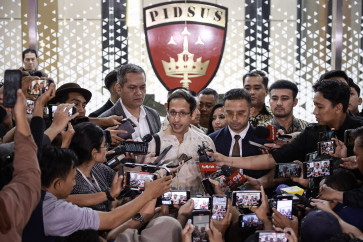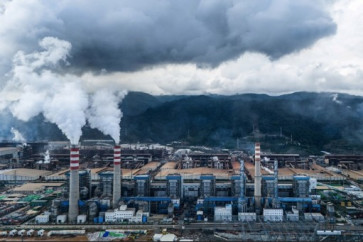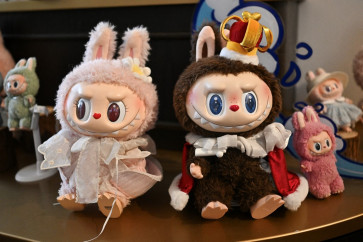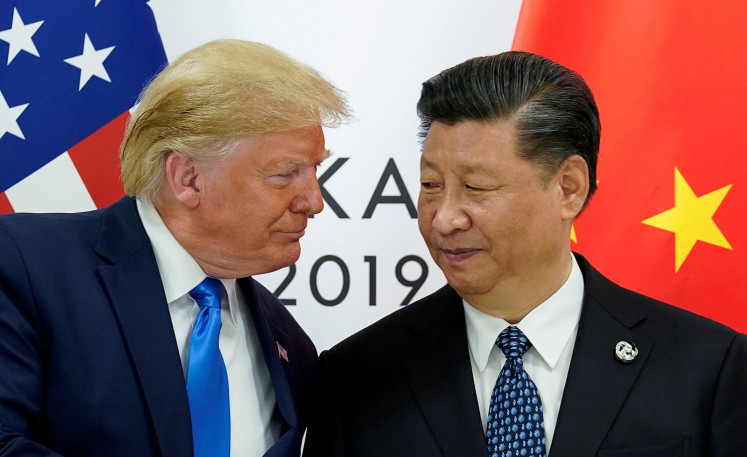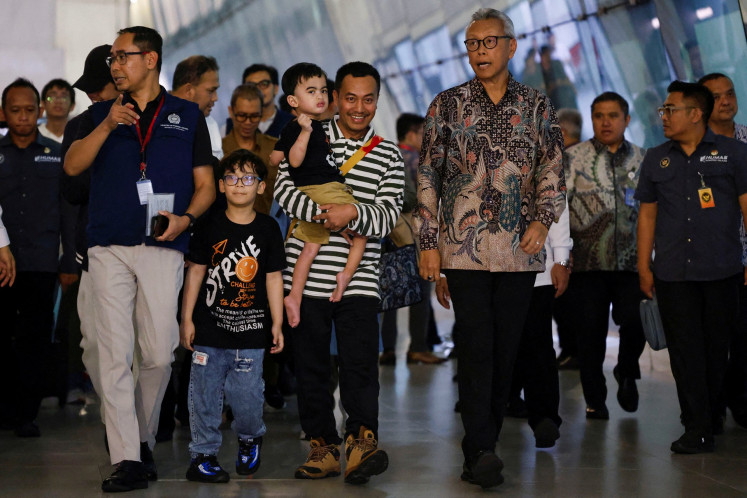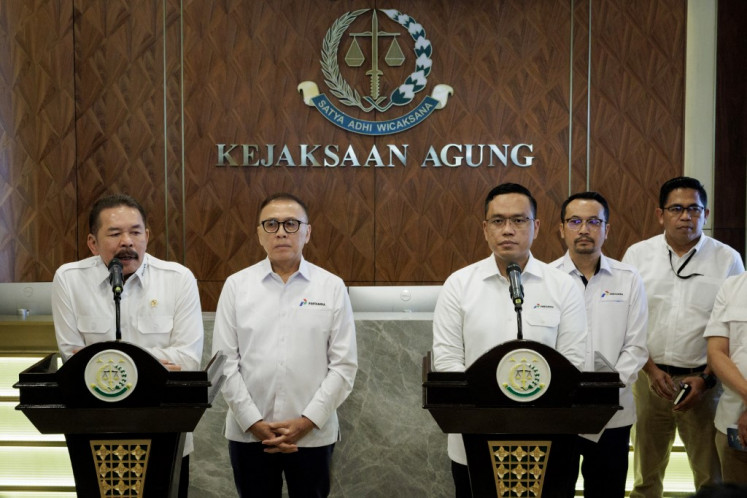Popular Reads
Top Results
Can't find what you're looking for?
View all search resultsPopular Reads
Top Results
Can't find what you're looking for?
View all search resultsLooking for oil finding Borneo
On display: Cultural observer Pindi Setiawan (right) discusses the images of Wolfgang Leupold with Dutch Ambassador Tjeerd de Zwaan (left) and Swiss Ambassador Heinz Walker-Nederkoorn
Change text size
Gift Premium Articles
to Anyone
 On display: Cultural observer Pindi Setiawan (right) discusses the images of Wolfgang Leupold with Dutch Ambassador Tjeerd de Zwaan (left) and Swiss Ambassador Heinz Walker-Nederkoorn. (JP/DON)" border="0" height="333" width="500">On display: Cultural observer Pindi Setiawan (right) discusses the images of Wolfgang Leupold with Dutch Ambassador Tjeerd de Zwaan (left) and Swiss Ambassador Heinz Walker-Nederkoorn. (JP/DON)
On display: Cultural observer Pindi Setiawan (right) discusses the images of Wolfgang Leupold with Dutch Ambassador Tjeerd de Zwaan (left) and Swiss Ambassador Heinz Walker-Nederkoorn. (JP/DON)" border="0" height="333" width="500">On display: Cultural observer Pindi Setiawan (right) discusses the images of Wolfgang Leupold with Dutch Ambassador Tjeerd de Zwaan (left) and Swiss Ambassador Heinz Walker-Nederkoorn. (JP/DON)
The dense jungles of Borneo Island were an unknown place to Europeans in the 1920s.
However, a Swiss geologist searching for oil in Kalimantan, as the island is now known in Indonesia, also brought along his camera â and made a remarkable record of life at the time.
Sixty-four photographs taken by the geologist, Wolfgang Leupold, from the collections of his family and and the Royal Netherlands Institute of Southeast Asian and Caribbean Studies (KITLV), are currently on display at the âMemories from Borneoâ exhibition at the Erasmus Huis cultural center in South Jakarta.
âThe exhibition gives some insight into a fascinating culture, while at the same time throwing light on the use of photography at an early age as a tool to map the lives and times of people and the culture of Borneo [Kalimantan],â said Dutch Ambassador to Indonesia Tjeerd de Zwaan.
Leupold was among a group of Swiss geologists hired by the colonial government of the then-Dutch East Indies to conduct geological research on petroleum.
He and his wife, Erika, first came to Batavia near the end of 1921 before receiving instructions to go to northeast of Borneo, where oil had been discovered in Tarakan.
They arrived in Tanjung Selor in the north of Kalimantan in 1922 before moving to Tarakan. The Leupolds later relocated to Bunyu Island, where their first stationary camp was located.
 (JP/DON)
(JP/DON)
There, Leupold had a house built with a veranda built from timber and leaf panels.
Apart from his research, Leupold was a photography enthusiast. With his German-made Contessa-Nettel camera, he took many personal and work-related pictures.
âHe documented everything that interested him [and] a large portion of photos of landscapes that he visited and explored. Other parts involved the drill towers and facilities â a treasure to be discovered about the mining history of the predecessor of [state-owned oil and gas company] Pertamina,â Swiss Ambassador to Indonesia Heinz Walker-Nederkoorn said.
âLeupold also used his camera to capture images in his living room, which had a mixture of European and Indonesian furnishings and objects,â he added.
In 1923, his son, Urs, was born and soon became one of Leupoldâs favorite subjects for his camera.
Many images at the exhibition are portraits of people Leupold met, including local residents he recruited to help during his expeditions.
He took pictures of the members of several indigenous tribes, such as the Kenyah and Kayan, as well as the nomadic Punan and Basap people who guided him on expeditions to explore the islandâs waterways and rain forests.
Most of the pictures were taken between 1922 and 1924 during his stay; researchers were not able to date pictures from later periods.
span class="caption" style="width: 498px;">On display: Cultural observer Pindi Setiawan (right) discusses the images of Wolfgang Leupold with Dutch Ambassador Tjeerd de Zwaan (left) and Swiss Ambassador Heinz Walker-Nederkoorn. (JP/DON) However, a Swiss geologist searching for oil in Kalimantan, as the island is now known in Indonesia, also brought along his camera ' and made a remarkable record of life at the time.
O
The dense jungles of Borneo Island were an unknown place to Europeans in the 1920s.
Sixty-four photographs taken by the geologist, Wolfgang Leupold, from the collections of his family and and the Royal Netherlands Institute of Southeast Asian and Caribbean Studies (KITLV), are currently on display at the 'Memories from Borneo' exhibition at the Erasmus Huis cultural center in South Jakarta.
'The exhibition gives some insight into a fascinating culture, while at the same time throwing light on the use of photography at an early age as a tool to map the lives and times of people and the culture of Borneo [Kalimantan],' said Dutch Ambassador to Indonesia Tjeerd de Zwaan.
Leupold was among a group of Swiss geologists hired by the colonial government of the then-Dutch East Indies to conduct geological research on petroleum.
He and his wife, Erika, first came to Batavia near the end of 1921 before receiving instructions to go to northeast of Borneo, where oil had been discovered in Tarakan.
They arrived in Tanjung Selor in the north of Kalimantan in 1922 before moving to Tarakan. The Leupolds later relocated to Bunyu Island, where their first stationary camp was located. 
There, Leupold had a house built with a veranda built from timber and leaf panels.
Apart from his research, Leupold was a photography enthusiast. With his German-made Contessa-Nettel camera, he took many personal and work-related pictures.
'He documented everything that interested him [and] a large portion of photos of landscapes that he visited and explored. Other parts involved the drill towers and facilities ' a treasure to be discovered about the mining history of the predecessor of [state-owned oil and gas company] Pertamina,' Swiss Ambassador to Indonesia Heinz Walker-Nederkoorn said.
'Leupold also used his camera to capture images in his living room, which had a mixture of European and Indonesian furnishings and objects,' he added.
In 1923, his son, Urs, was born and soon became one of Leupold's favorite subjects for his camera.
Many images at the exhibition are portraits of people Leupold met, including local residents he recruited to help during his expeditions.
He took pictures of the members of several indigenous tribes, such as the Kenyah and Kayan, as well as the nomadic Punan and Basap people who guided him on expeditions to explore the island's waterways and rain forests.
Most of the pictures were taken between 1922 and 1924 during his stay; researchers were not able to date pictures from later periods.
Walker-Nederkoorn said according to the journal of Leupold's wife, the geologist typically developed his negatives at night, writing captions on the back of the photographs. He also made glass slides for the purposes of projection.
'The pictures and Leupold's notes provide useful ethnographic information and give some hints as to how some groups, including some Europeans, lived, worked and traded together,' he said.
Unfortunately, nearly all of the original negatives have been lost.
After six years in Indonesia, Leupold and his family returned to Europe in the summer of 1927.
Walker-Nederkoorn said that many items and photographs
that Leupold collected while in Borneo were donated to Ethnographic Museum of the University of Zurich by his family to make them accessible for researchers and the general public.
'All these documents were very important in bringing to life the experience of a Swiss family ' and to explore a small but very descriptive chapter of the entangled history between Switzerland, the Netherlands and Indonesia in the colonial context,' he said.
'Memories from Borneo' closes on May 6. For information visit erasmushuis.nlmission.org.
Your Opinion Matters
Share your experiences, suggestions, and any issues you've encountered on The Jakarta Post. We're here to listen.
Thank You
Thank you for sharing your thoughts. We appreciate your feedback.
Share options
Quickly share this news with your network—keep everyone informed with just a single click!
Gift Premium Articles
to Anyone
Share the best of The Jakarta Post with friends, family, or colleagues. As a subscriber, you can gift 3 to 5 articles each month that anyone can read—no subscription needed!
Continue in the app
Get the best experience—faster access, exclusive features, and a seamless way to stay updated.

